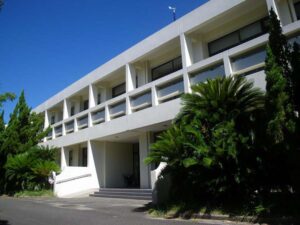In 1922, the laboratory was established as a Marine Biological Research Station, the Faculty of Science, Kyoto Imperial University in the area called Kikyou Daira of Bansho Zaki Cape by purchasing the land from Seto Kanayama Town. In 1930, the aquarium rooms were open to the public in memorial of the visit of Showa Emperor (Hirohito). In 1938, the laboratory was renamed as Seto Marine Biological Laboratory. The first director was Prof. Komai. In 1968, Kyoto University purchased Hatake- Jima Island in Tanabe Bay as an experimental field. In 2003, the laboratory was reorganized into a part of the Field Science Education and Research Center, Kyoto University.
The laboratory consists of 40,630m2 land, 26,530m2 Hatake-Jima Island (an experimental field) and 5,680m2 buildings. The laboratory has two boats, Janthina (12 t, 24 person-capacity) and Zoea (1.3 t, 10 person-capacity). The Shirahama Aquarium attached to the laboratory is open to the public.
Main focus of research made at Seto Marine Biological Laboratory has been mainly on taxonomy and phylogeny of marine invertebrates. Especially, regarding study on Cnidaria, Ctenophore, Mollusca, Arthropoda, Chaetognatha and Chordata, SMBL has been one of major institutes for those fields in the world. Ecological study of marine plankton and benthos, such as distribution, population, community structure, life history, species interaction and ethology have been also made. SMBL has been publishing “Publications of Seto Marine Biological Laboratory” as an international journal since 1949.

Seto Marine Biological Laboratory, Field Science Education and Research Center, Kyoto University
address: 459 Shirahama-cho, Nishimuro-gun, Wakayama, 649-2211
Tel: +81-(0)739-42-3515; Fax: +81-(0)739-42-4518
